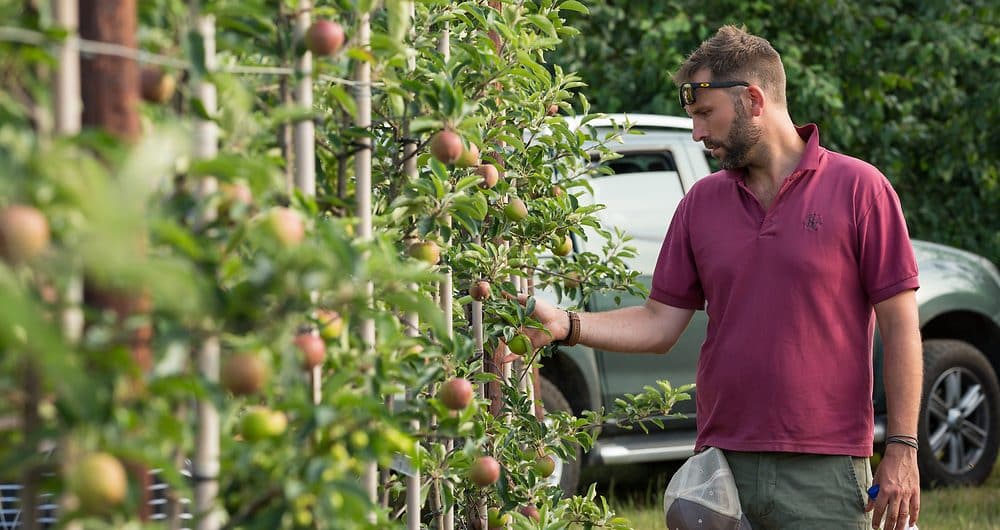Groundbreaking precision project for UK orchards – Precise
A unique project to develop a commercially viable system for precisely targeting orchard inputs to specific trees, or even parts of a tree, has been given the go-ahead ...
Led by Hutchinsons agronomist, Rob Saunders, and part-funded by the commercial partners, Innovate UK and DEFRA, the four-year, £4.5m Precision Orchard Management for the Environment (POME) project is using cutting-edge technology to digitally examine fruit trees in fine detail, allowing inputs to be targeted in a way that has never been seen before in UK orchards.
“The ultimate aim is to reduce the environmental impact of tree fruit production by using fewer plant protection products, while simultaneously increasing orchard production efficiency, output and profitability through increased yield and grade-out,” says Mr Saunders.
The system will use digital scanning to generate precision dosing maps for blossom and fruit thinning, fertiliser application, growth regulators, pest control, and fungicides, as well as provide more accurate yield forecasting for growers.
The integration with precision dosing application equipment will together help to reduce the use of plant protection products, increase yields and cut fruit losses, he says.
“It’s about raising the efficiency of how we use all resources that go into fruit production, including the land.”
TAKING PRECISION TO THE NEXT LEVEL
POME builds on work undertaken in a separate Innovate UK-funded Precision Orchard Dosing System (PODS) project that used LIDAR scanning of trees in winter to map height and density, before a drone-based scan in the spring to assess blossoms. This data was analysed using machine vision and machine learning to develop a variable rate plan for applying thinners and growth regulators through a purpose-built sprayer fitted with RTK-GPS and robotic localisation and mapping techniques, giving high levels of accuracy in complicated horticulture environments.
COMMERCIAL POTENTIAL
“The aim of PODS was to prove the concept could work and develop a prototype,” explains Mr Saunders. “Now, with the new POME project, we want to take all of that work onto the next stage and develop a commercially viable precision orchard management system that is ready for market in the next four years.”
He acknowledges it is an ambitious task, but one that he believes is entirely feasible given the world-leading, industry-wide consortium involved in the project. Alongside Hutchinsons, this includes engineers N.P. Seymour; Global Navigation Satellite System and software developer The Acclaimed Software Company; marketing desk Avalon Fresh; aerial imaging company Outfield; robotics firm Antobot; disease, pest and stress detection specialists Fotenix; horticultural experts from NIAB East Malling; data science expertise from NIAB Cambridge; agri-economics from the University of Kent; robotics and automation expertise from Loughborough University; and the Health and Safety Executive’s Chemicals Regulation Division (CRD).
REGULATOR INVOLVEMENT
“It’s important that regulators understand what we are doing and CRD are involved in the project to help design trials that are useable for regulatory purposes. In the long-term, precision application systems such as this may even help to secure the future approval for certain products.
“Of course, no system, however good it is, will be any use unless it is practically and economically attractive to growers, so we’ve also enlisted the help of two commercial farms in Kent – Plumford Farms Ltd and ACH Farming Ltd – that will test the new system as we develop it.”
How POME will work
There are three main elements to the POME project. The starting point is to gather data about the health and growth of orchard trees autonomously, rather than relying on the agronomist or grower having to walk up and down rows looking for differences or potential issues.
The team is developing three main ways of collecting data, including:
- Tractor-mounted sensors (e.g.hyperspectral imagery, NDVI, LIDAR scanning) to identify any variations in tree health or development. Having sensors mounted on the tractor allows a range of data to be collected every time the tractor passes through the orchard doing other operations
- Drone surveying during the flowering period to map blossom intensity of individual trees across the entire orchard
- Robot scanning from the ground. Scanning during daytime can be affected by variations in natural light intensity, therefore robot scanning will be done autonomously at night using artificial lights fitted to the vehicle, and carried out at low speeds that would not be practical for a tractor-based operation.
These three sources of data will then be brought together into a central computer software platform where everything can be analysed and interpreted to ultimately generate a user-friendly digital map of the orchard highlighting variations in any of the factors that the sensors recorded. This could include areas of a specific disease, or, as in the PODS project, variability in the size, density and crop load of individual trees-a major cause of sub-optimal yield and quality in commercial fruit orchards.
The final part of the project will develop a commercially viable application system that can use the data and digital maps generated to vary inputs according to the specific requirements of individual trees.
To achieve this level of detail requires a consistently high degree of accuracy, both in the mapping of crops, and in the variable application of inputs, Mr Saunders says. This is why Loughborough University has been enlisted, to provide its cutting-edge machine learning and location system, which can deliver exceptionally high centimetre-level navigation accuracy.
“Some might think that systems like this are complicated and expensive, and only suited to very large-scale farms. The system we are building will cater for different sizes of farm business and with optional services depending on the farm’s need. The industry has changed a lot in recent years and will continue to do so as technology advances, and we believe systems like this will become commonplace.
